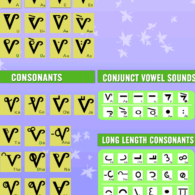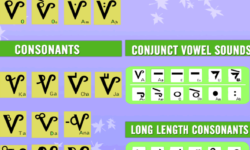Profile
Rana is one of nearly twenty scripts created by Dr. Prasanna Sree for indigenous and minority groups, mostly in Andhra Pradesh. In each case, the design of the script reflects some iconic feature of the culture of that linguistic community. She writes:Rana is spoken in the agency areas of Visakhapatnam and Vizianagaram districts of Andhra Pradesh in India. The Ranas, who are also known as Rena or Rona, speak Odia in addition to their own language. According to the 1991 census, their population is 358. The total literacy rate among Rona is 40.72.
Cross-cousin marriages are common and levirate and sororate are allowed in the community. Elopement and negotiation are the modes of acquiring spouses. Bride price is paid in kind. Remarriage is allowed for widow and divorcee. Nuclear families are common. They follow the rule of patrilineal descent and patrilocal residence. Divorce is permissible.
The main occupation of Rona is settled agriculture. They work as wage labourers. Their traditional community council is headed by a Naidu. They celebrate the festivals of Itukulapanduga, Korrakotha, and Jodlapanduga, besides Hindu festivals like Sivarathri, Ugadi and Deepavali.
The common element in the design of the Rana script represents a catapult.
Rana means “war,” and the Rana represent a warrior class. Their homes are like sun-baked mud castles, protected by trees pruned into V shapes. When these trees are equipped with slings made of animal fat, they can be used as catapults, firing up to 100 ammunition balls in a wide field of fire.
You can help support our research, education and advocacy work. Please consider making a donation today.


